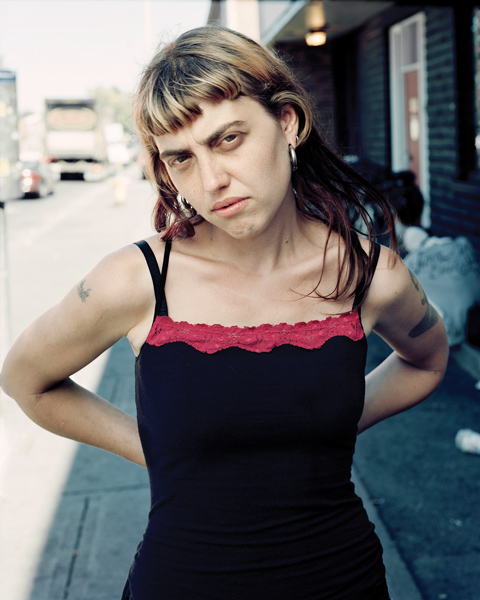[Fall 2009]
iPs Gallery
Montreal June 6 to 27, 2009
Crack cocaine is the classic drug of addiction nightmares: it gets you high for five or ten minutes, and then haunts you for the rest of your life. The most addictive form of any drug, crack turns most of its users into dependents, the majority of whom spend their lives chasing the memory of that first high – a blissful, dopamine-induced euphoria whose original intensity will forever elude them. Sadly, most addicts take crack to dull memories of painful or traumatic experiences, exchanging one set of miseries for another. In the words of Rose, a longterm addict now living on the streets, “I call crack cocaine the Devil, and I married him.”1
Much time and public money is spent trying to make downtown Ottawa into a flower-filled historic site free of vagrants and drug addicts. Despite various programs and crackdowns, street people continue to live there and take part in the urban community. Since 2007, photographer Tony Fouhse has been visiting a particular street corner in Ottawa’s Lowertown, a kind of micro-version of Vancouver’s East Hastings. Made up largely of crack addicts, the community that congregates there is not hidden, and its proximity to the fashionable Byward Market makes it easy to wander into unawares. In this part of the city, at any time of the day, it feels like Ottawa has been turned upside-down.
Fouhse’s project USER began here, at the invitation of Archie, a local addict who randomly asked, “Are you looking for a subject?” Recently on display at iPs Gallery in Montreal in an exhibition curated by Penny Cousineau-Levine and Zoe Casino, this ongoing photographic collaboration with Lowertown crack addicts is currently made up of two separate bodies of work. The first and earlier of these, USER: Night (2007), consists of a series of striking portraits shot at dusk with a medium-format camera. The aestheticism of these portraits, infused with references to the history of painting – and to mannerism in particular – unleashed a storm of controversy when they were first exhibited in Ottawa. Several viewers accused Fouhse of exploiting the addicts for his own narrow purposes, feeding their addiction in order to realize a selfish artistic vision. In actuality, the portraits developed out of an ongoing relationship with the addicts. The assumption that they did not actively participate in the construction of these images – that they are not capable of this or any other form of self-determination – is far more dehumanizing than are exploitative photographs. As Fouhse notes in his artist’s statement, “Some have said I’m collaborating with the enemy. They say that the addicts on that corner should be swept away. Of course, where they’ll go, how they’ll be treated is left unsaid.”2
In his more recent series of portraits from the corner, USER: Women (2009), Fouhse has chosen to focus exclusively on female addicts. These tightly composed headshots, all of which were taken with a large-format camera, are some of his most successful photographs to date, offering a more serious and soulful consideration of his subjects. Apart from the information given in the title of each portrait, there is very little to suggest that these women are crack addicts. This is, of course, the point of the project: to identify users not as just addicts, but as valuable, interesting, and creative human beings with a past – and with a future, no matter how bleak or marginal we may choose to imagine it.
It is interesting to note that although the portraits in USER: Women are just as con- structed as Fouhse’s previous night series, they have elicited a slightly less polemical response. One may speculate that this is because the headshots are more in line with a documentary aesthetic that viewers feel comfortable with. It may be because they assume, incorrectly, that the women are not participating in the composition of the photos, and that this is somehow more ethical. (Ironically, the media have trained us to equate lack of agency by the subject with ethical conduct by the photographer.) There is also a certain feminist perspective from which it might be observed that the public finds images of vulnerable, addicted women more acceptable. In this context, it will be interesting to see the reaction to the next series in USER, which will focus only on male addicts.
Emily Falvey is a Montreal-based independent curator and art critic. She was Curator of Contemporary Art at the Ottawa Art Gallery from 2004 to 2008. In 2006 she received the Curatorial Writing Award (Contemporary Essay) from the Ontario Association of Art Galleries.


